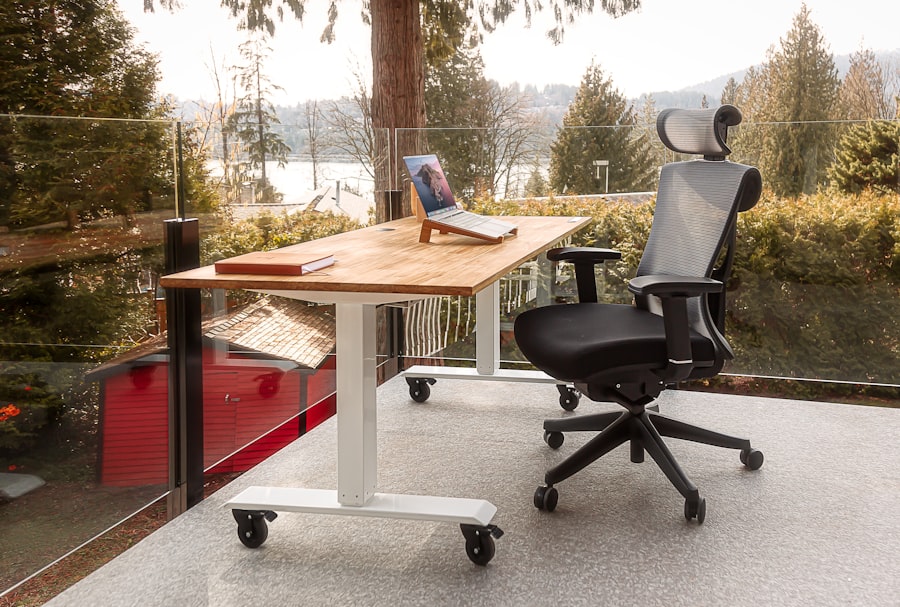In today’s fast-paced business environment, the significance of modern office furniture cannot be overstated. The design and functionality of office furniture play a crucial role in shaping the work experience for employees. Modern office furniture is not merely about aesthetics; it encompasses ergonomic considerations, adaptability, and the ability to foster collaboration among team members.
A well-furnished office can enhance employee morale, promote productivity, and even influence the overall company culture. For instance, open-plan offices equipped with modular furniture can facilitate communication and teamwork, while private workstations can provide the necessary focus for tasks requiring deep concentration. Moreover, modern office furniture reflects the evolving nature of work itself.
With the rise of remote work and flexible schedules, businesses are increasingly investing in furniture that can accommodate various working styles. This includes adjustable desks that allow employees to alternate between sitting and standing, as well as collaborative spaces that encourage brainstorming and innovation. The importance of modern office furniture extends beyond mere functionality; it also communicates a company’s values and commitment to employee well-being.
A thoughtfully designed workspace can attract top talent and retain existing employees by creating an environment that is both comfortable and inspiring.
Key Takeaways
- Modern office furniture is important for creating a professional and comfortable work environment
- Choose modern office furniture that fits the needs and style of your workspace
- Create a functional and stylish workspace by incorporating modern office furniture that maximizes space and efficiency
- Incorporate ergonomic design into your office space to promote employee health and productivity
- Maximize productivity with modern office furniture that encourages collaboration and creativity
Choosing the Right Modern Office Furniture for Your Workspace
Introduction to Office Furniture Selection
Selecting the appropriate modern office furniture requires a careful assessment of both the physical space and the specific needs of the workforce. One of the first steps in this process is to evaluate the layout of the office. Understanding how different areas will be utilized—whether for individual work, meetings, or collaborative projects—can guide decisions on what types of furniture to incorporate.
Evaluating Workspace Needs
For example, if a significant portion of the workforce engages in teamwork, investing in large conference tables and comfortable seating arrangements can facilitate group discussions and brainstorming sessions. This consideration is crucial as it directly impacts the productivity and efficiency of the team. By understanding the specific needs of different areas within the office, businesses can make informed decisions about the type of furniture that will best support their operations.
Aesthetic Considerations
Additionally, it is essential to consider the aesthetic appeal of the furniture. Modern office furniture comes in a variety of styles, colors, and materials, allowing businesses to create a cohesive look that aligns with their brand identity. For instance, a tech startup may opt for sleek, minimalist designs with vibrant colors to reflect its innovative spirit, while a law firm might choose more traditional furnishings that convey professionalism and stability.
Creating a Harmonious Workspace
Ultimately, the right choice of furniture should harmonize with the overall design theme of the office while also catering to the functional requirements of employees. By balancing aesthetic appeal with functional needs, businesses can create a workspace that is both productive and inviting, reflecting the unique character and values of the organization.
Creating a Functional and Stylish Workspace with Modern Office Furniture

Creating a workspace that is both functional and stylish involves a thoughtful combination of design elements and practical considerations. Modern office furniture offers a plethora of options that can enhance both form and function. For instance, incorporating multi-functional pieces such as desks with built-in storage or modular seating that can be rearranged as needed can maximize space efficiency while maintaining an attractive appearance.
This flexibility is particularly beneficial in dynamic work environments where team configurations may change frequently. In addition to functionality, style plays a pivotal role in establishing an inviting atmosphere. The use of color, texture, and design can significantly impact employee mood and productivity.
For example, incorporating natural materials like wood or plants can create a calming environment that promotes well-being. Furthermore, integrating elements such as artwork or decorative lighting can add personality to the workspace, making it more enjoyable for employees to spend their time there. By striking a balance between functionality and aesthetics, businesses can create an environment that not only meets operational needs but also inspires creativity and engagement.
Incorporating Ergonomic Design into Your Office Space
The integration of ergonomic design into modern office furniture is essential for promoting employee health and well-being. Ergonomics focuses on creating workspaces that fit the physical needs of individuals, thereby reducing discomfort and preventing injuries associated with prolonged sitting or repetitive motions. For instance, adjustable chairs that provide lumbar support can help maintain proper posture during long hours at a desk.
Similarly, sit-stand desks allow employees to alternate between sitting and standing positions, which can alleviate strain on the back and neck. Incorporating ergonomic principles into office design goes beyond just selecting the right furniture; it also involves considering the overall layout of the workspace. For example, ensuring that computer monitors are at eye level can prevent neck strain, while positioning frequently used items within easy reach can minimize unnecessary stretching or twisting.
Additionally, providing employees with tools such as keyboard trays or footrests can further enhance comfort. By prioritizing ergonomic design in the selection of modern office furniture, companies demonstrate their commitment to employee health, which can lead to reduced absenteeism and increased job satisfaction.
Maximizing Productivity with Modern Office Furniture
Modern office furniture has a direct impact on productivity levels within the workplace. The right furniture can create an environment conducive to focus and efficiency while minimizing distractions. For instance, sound-absorbing panels or privacy screens can help reduce noise levels in open-plan offices, allowing employees to concentrate better on their tasks.
Furthermore, collaborative spaces equipped with whiteboards or interactive displays can facilitate brainstorming sessions and enhance teamwork. Another aspect of maximizing productivity is ensuring that employees have access to technology and resources that support their work processes. This includes providing adequate power outlets for charging devices and ensuring that meeting rooms are equipped with necessary audiovisual equipment.
Additionally, modern office furniture often incorporates features such as cable management systems to keep workspaces tidy and organized. By investing in furniture that enhances both comfort and functionality, businesses can create an environment where employees feel empowered to perform at their best.
Trends in Modern Office Furniture

Sustainability Takes Center Stage
One prominent trend is the shift towards sustainability in furniture production. Many manufacturers are now prioritizing eco-friendly materials and processes, creating products that minimize environmental impact while still offering style and durability.
Flexible Workspaces for the Modern Era
Another significant trend is the rise of flexible workspaces that accommodate various working styles. This includes the incorporation of movable partitions that allow for quick reconfiguration of spaces based on team needs or project requirements.
Wellness-Oriented Designs for a Healthier Workplace
Additionally, there is an increasing emphasis on wellness-oriented designs that promote mental health and well-being. Features such as biophilic design—integrating natural elements into the workspace—are becoming more prevalent as companies recognize the benefits of connecting employees with nature. These trends reflect a broader understanding of how thoughtful design can enhance both employee satisfaction and overall organizational performance.
Budget-Friendly Options for Upgrading Your Workspace
Upgrading your workspace with modern office furniture does not have to break the bank; there are numerous budget-friendly options available that do not compromise on quality or style. One effective strategy is to consider purchasing pre-owned or refurbished furniture. Many companies offer high-quality second-hand pieces that have been restored to like-new condition at a fraction of the cost of new items.
This approach not only saves money but also contributes to sustainability by reducing waste. Another cost-effective option is to focus on key areas that will have the most significant impact on employee experience. For example, investing in ergonomic chairs for employees who spend long hours at their desks can lead to immediate improvements in comfort and productivity without requiring a complete overhaul of the office space.
Additionally, incorporating accessories such as desk organizers or task lighting can enhance functionality without substantial investment. By prioritizing strategic upgrades rather than an entire redesign, businesses can create an inviting workspace while staying within budget constraints.
Tips for Maintaining and Caring for Modern Office Furniture
Proper maintenance and care are essential for prolonging the lifespan of modern office furniture and ensuring it remains functional and aesthetically pleasing over time. Regular cleaning is one of the most straightforward yet effective ways to maintain furniture quality. Different materials require different cleaning methods; for instance, wooden surfaces may need periodic polishing to retain their luster, while fabric upholstery should be vacuumed regularly to prevent dust accumulation.
In addition to cleaning, it is important to address any minor repairs promptly to prevent further damage. For example, tightening screws on chairs or desks can prevent wobbling and ensure stability during use. Furthermore, rotating or rearranging furniture periodically can help distribute wear evenly across surfaces.
By implementing these maintenance practices, businesses can extend the life of their modern office furniture while creating a workspace that continues to inspire productivity and comfort for years to come.
If you are looking to create a modern and efficient office space, incorporating smart office technology is essential. This article discusses how integrating technology into the workplace can improve productivity and collaboration among employees. In addition to technology, having the right furniture is also crucial. A contemporary executive desk, like the ones featured in this article, can add a sleek and professional touch to any office space. Pairing this desk with top conference table options in Dubai, as highlighted in another article, can create a cohesive and stylish look for your office.
FAQs
What is modern furniture for office?
Modern furniture for office refers to contemporary and stylish furniture designed specifically for use in office spaces. It often features sleek lines, minimalistic designs, and innovative materials.
What are the benefits of modern furniture for office?
Modern furniture for office offers several benefits, including improved aesthetics, increased functionality, and enhanced comfort for employees. It also helps create a professional and welcoming environment for clients and visitors.
What are some common features of modern office furniture?
Common features of modern office furniture include ergonomic designs, adjustable components, space-saving features, and eco-friendly materials. It often incorporates technology and connectivity solutions to support modern work practices.
What types of modern furniture are suitable for office spaces?
Modern office furniture includes desks, chairs, storage units, conference tables, reception counters, and collaborative workstations. It also encompasses accessories such as lighting, shelving, and organizational tools.
How can modern furniture improve productivity in the office?
Modern furniture can improve productivity in the office by providing ergonomic support, promoting collaboration, and creating a comfortable and inspiring work environment. It can also help optimize space and streamline workflow.


